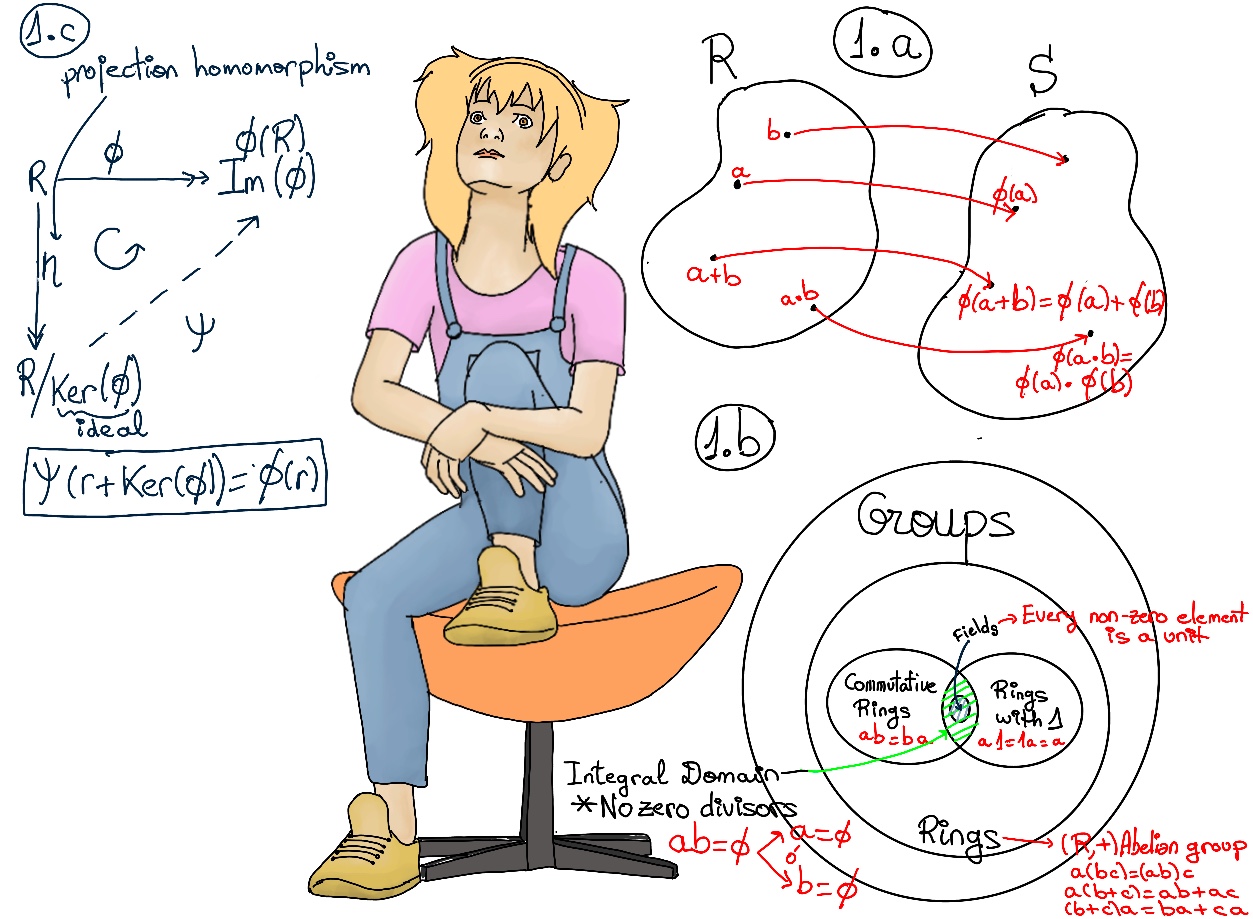
|
 |
 |

|
 |
 |
“If you are going through hell, be tough and keep going, but if you are in a big, deep, ugly shithole, stop digging,” Matthew retorted, but what he meant, not even he knew for sure, but it sounded cool and super positive though, Apocalypse, Anawim, #justtothepoint.
A ring homomorphism Φ from a ring R to a ring S is a structure-preserving function or mapping between two rings. More explicitly, it is a function Φ: R → S such that Φ is addition, multiplication, and unit (multiplicative identity) preserving, Φ(a + b) = Φ(a) + Φ(b), Φ(ab) = Φ(a)Φ(b), Φ(1R) = 1S, ∀a, b ∈ R. Figure 1.a.
💣In our original definition, a ring does no need to have a multiplicative identity, other authors define a ring to have a multiplicative identity and without the requirement for a multiplicative identity is instead called a rng, a non-unital ring or pseudoring. Φ(1R) = 1S only applies when a ring do have a multiplicative identity.


Theorem. There is a unique or canonical ring homomorphism from the ring of integers to any ring. Let R be a ring with unity or multiplication identity 1 (or just a ring depending on your definition, ring versus rng - a non-unital ring or pseudoring-).
Proof.
Theorem. Every ring with unity has a subring isomorphic to either ℤ or ℤn. Let R be a ring (or a ring with unity depending on your definition). If Char(R) = n, then R contains a subring isomorphic to ℤn. If Char(R) = 0, then R contains a subring isomorphic to ℤ.
Proof.
Let 1 be the unity of R. The previous result shows that Φ: ℤ → R, Φ(n) = n·1R is a homomorphism ⇒ [By the First Isomorphic Theorem for Rings] ℤ/Ker(Φ) ≋ Φ(ℤ).
Recall Let Φ: R → R' be a ring homomorphism and S be a subring of R ⇒ Φ(S) is a subring of R'. In particular, Φ(R) is a subring of R’.
Ker(Φ) = ⟨n⟩ where n is the additive order of 1R, that is, Φ(n) = n·1R = 1R + 1R + ··n times·· + 1R = 0R ⇒ If Char(R) = n, Φ(ℤ) ≋ ℤ/⟨n⟩ ≋ ℤn, hence R contains a subring, namely Φ(ℤ), isomorphic to ℤn. Otherwise, if Char(R) = 0, Φ(ℤ) ≋ ℤ/⟨0⟩ ≋ ℤ.
Recall, by Characteristic of a Ring with Unity. If 1 has infinite order under addition, then char(R) = 0. If 1 has order n under addition, then char(R) = n.
Φ(0) =[Φ is a ring homomorphism] 0.
0 = Φ(n + (-n)) = Φ(n) + Φ(-n) = n + Φ(-n) ⇒ n + Φ(-n) = 0 ⇒ Φ(-n) = -n.
1 = Φ(1) = Φ(1/n + ··n times·· + 1/n) = Φ(1/n) + ··n times·· + Φ(1/n) = nΦ(1/n) ⇒ nΦ(1/n) = 1 ⇒ Φ(1/n) = 1/n.
∀m/n ∈ ℚ, Φ(m/n) = Φ(m·1/n) = Φ(m)Φ(1/n) = m·1/n = m/n, Φ is the identity. Therefore, a ring homomorphism over rational numbers is either the trivial homomorphism or the identity.
Let’s set Φ(1) = a ⇒ a2 = a·a = Φ(1)·Φ(1) = Φ(1·1) = Φ(1) = a ⇒ a2 = a ⇒[An idempotent element of a ring is an element a such that a2 = a, e.g., 0, 1, 3, and 4 are idempotent elements of ℤ/6ℤ. A trivial idempotent refers to either of the elements 0 and 1, which are always idempotent.] 0, 1, 8, and 21 are idempotent elements of ℤ28, so a = Φ(1) = 0, 1, 8, or 21.
Recall (group abstract algebra and group homomorphisms) that |Φ(1)| | |1| and we are talking about the additive order (inside the additive group) of Φ(1) -ℤ28- and 1 -ℤ12- respectively ⇒ |Φ(1)| = |a| | 12 (= |1| in ℤ12) ⇒ |a| ∈ {1, 2, 3, 4, 6, 12}.
Besides, recall (cyclic groups) that in ℤn, |k| = $\frac{n}{gcd(n, k)}$, and therefore n = 28, (a = 0, 1, 8 and 21), |0|ℤ28 = 1, |1|ℤ28 = 28 ∉ {1, 2, 3, 4, 6, 12}, |8|ℤ28 = $\frac{n}{gcd(n, k)}= \frac{28}{gcd(28, 8)} = \frac{28}{4} = 7$ ∉ {1, 2, 3, 4, 6, 12}, and finally |21|ℤ28 = $\frac{n}{gcd(n, k)}= \frac{28}{gcd(28, 21)} = \frac{28}{7} = 4$, so the only possibilities are a = 0 or 21.
Corollary. ℤn is a homomorphic image of ℤ.
Proof.
There are two different approaches.
If Φ: R → S ring homomorphism is also onto, then Φ is called an epimorphism and S is called a homomorphic image of R.
Corollary. Every field has a subfield isomorphic either to ℤp or to ℚ. Let F be a field. If Char(F) = p, then F contains a subfield isomorphic to ℤp. If Char(F) = 0, then F contains a subfield isomorphic to ℚ.
Proof:
Recall that a field is a commutative ring with unity such that each nonzero element has a multiplicative inverse, e.g., every finite integral domain, ℤp (p prime), ℚ, ℝ, and ℂ. A field has characteristic zero or characteristic p with p prime.
By the previous result, if Char(F)=p, then F contains a subring isomorphic to ℤp and we are done.
If Char(F) = 0, then F has a subring S isomorphic to ℤ. Φ: ℤ → F, Φ(n) = n·1F, Φ is a ring homomorphism, and by the first isomorphism theorem for rings, ℤ/⟨0⟩ ≋ ℤ ≋ Φ(ℤ), i.e., S = Φ(ℤ) is a subring of F isomorphic to ℤ. Therefore, S = {n·1F: n ∈ ℤ} ⊆subring of F.
Let T =[Since a field must have all multiplicative inverses of n·1F, n ≠ 0] {ab-1 | a, b ∈ S, b ≠ 0}. Claim: T is a subfield of F (it is left as an exercise) and T ≋ ℚ.
Recall that a field F is a commutative (the multiplication is commutative) division ring.
Let Φ be the mapping: T → ℚ, Φ(ab-1) = a/b. More precisely, it would be (m·1F)(n·1F)-1 → m/n.
Φ is well defined. Similar argument Φ is injective.
Φ is a ring homomorphism. Φ(ab-1 + cd-1) =[Since (F,·) is commutative, ab-1 + cd-1 = adb-1d-1 + bcb-1d-1] Φ((ad + bc)(bd)-1) = (ad + bc)/bd = ad/bd + bc/bd = a/b + c/d = Φ(ab-1) + Φ(cd-1).
Φ((ab-1)(cd-1)) =[Since (F,·) is commutative] Φ(acb-1d-1) = Φ((ac)(bd)-1) = ac/bd = (a/b)(c/d) = Φ(ab-1)Φ(cd-1)
Φ is injective. Suppose Φ(ab-1) = Φ(cd-1) ⇒ a/b = c/d ⇒ ad = cb ⇒ adb-1 = cbb-1 ⇒[Since (F,·) is commutative] ab-1d = c ⇒ ab-1 = cd-1.
By construction, Φ is onto ∎
Since the intersection of all subfields of a field is a subfield, too, every field has a smallest subfield called the prime subfield of the field.
If Char(F)=p, the prime subfield is isomorphic to ℤp. Otherwise, if Char(F) = 0, the prime subfield is isomorphic to ℚ.
Third ring isomorphism theorem. Let R be a ring with ideals I ⊆ J ⊆ R. Then, $\frac{R/I}{J/I} ≋ R/J$.
Proof:
Let’s define a map Φ: R/I → R/J given by Φ(r + I) = r + J.